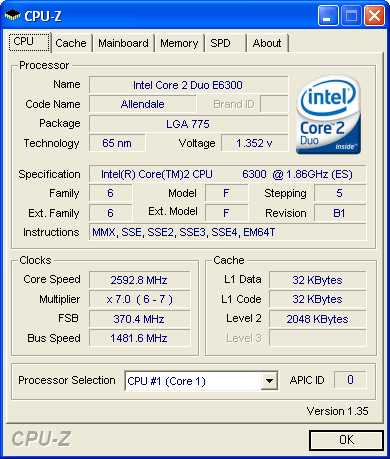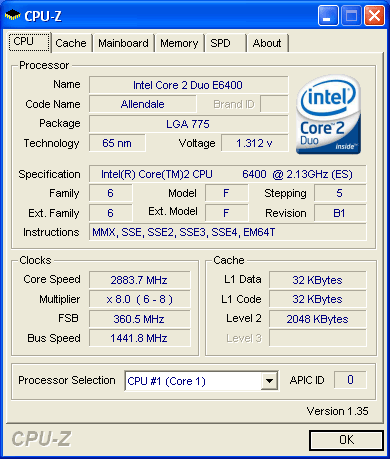Intel Core 2 Duo E6300 & E6400: Tremendous Value Through Overclocking
by Anand Lal Shimpi on July 26, 2006 8:17 AM EST- Posted in
- CPUs
Overclocking
Overclocking lower end CPUs is always more fun if you're actually buying these things because, as long as the manufacturing process is mature and your component selection is sound, you're usually able to reach much higher speeds than you paid for - an ever rewarding achievement. The Athlon 64 X2 CPUs have been fairly good overclockers, with the X2 3800+ usually able to run anywhere from 4600+ speeds (2.4GHz) up to FX-62 speeds (2.8GHz) and sometimes slightly beyond (3.0 - 3.1GHz). While we don't have any Socket-AM2 Athlon 64 X2 3800+ CPUs on hand (we will use a 4600+ and underclock it for our benchmarks), we do have performance results of the X2 4200+, 4600+ and FX-62 to give you an idea of where an overclocked X2 3800+ can get you performance-wise.
What we didn't know previously however was how far we could overclock retail E6300/E6400 CPUs, and furthermore we had no idea what a highly overclocked 2MB Core 2 Duo CPU would perform like. Armed with two B1 stepping Core 2 Duo CPUs, one E6300 and one E6400, we went to task on overclocking them. Our goal wasn't to reach the absolute highest overclocks using high end cooling, but rather the maximum stable overclocks easily attainable with a stock Intel heatsink/fan. Undoubtedly we could have reached higher frequencies with more elaborate cooling, but we were more interested in the bare minimum of what was attainable - and we weren't disappointed.
Our E6300 was able to reach 2.592GHz using a 370MHz FSB at 1.400V (up from 1.320V stock):

Our E6400 was a bit more successful, reaching 2.88GHz using a 360MHz FSB at 1.350V (up from 1.300V stock):

Both CPUs were totally stable when overclocked and were able to complete our multiple days of benchmarking without behaving any less stable than when clocked at their default frequencies.










137 Comments
View All Comments
bob661 - Wednesday, July 26, 2006 - link
I wonder if motherboard prices fore the Conroe's will go down once Nvidia and ATI start making chipsets for those CPU's.Sunrise089 - Wednesday, July 26, 2006 - link
I'm sure they will, and I will myself switch to Conroe when prices drop enough.For now though, there seem to be many questions left unanswered: how much these chips actually overclock (seems both that low-end parts do not overclock nearly as well as high-end, which is very different from X2s, and it also seems that not everyone is matching AT's overclock results), how expensive of a motherboard you need to get a good overclock (seems like a very expensive one, very different from X2s once again, where a cheap DFI Infinity or ePox motherboard overclocks basically as well as an expensive ASUS), and my above point of whether or not Conroe is actually faster dollar for dollar at the X2 5000+ level and below (I suspect it isn't). These articles need to be adressing these above points, rather than pointing out what we already understand - yes Conroe is faster clock for clock.
Anandtech is doing something very dangerous by putting certain chips together in people's minds. The X2 3800+ and E6300 are NOT competitors, the AMD part is probably $150 cheaper after motherboard purchase. But since AT is placing ideas in people's heads about the Intel part being so much faster, when Conroe is available for purchase and the very possible price-gouging takes place, people are still going to buy them thanks to sloppy reporting, since they are now convinced that Conroe destroys AMD's equivilent chips by such a large degree, and therefore paying $250 for a E6300 must still be a good choice. If AT were instead comparing the E6300 to a X2 5000+, buyers would see the true performance difference, and then be able to figure out that if the Intel part is at all above MSRP it isn't a good deal with these motherboard prices.
dev0lution - Wednesday, July 26, 2006 - link
Again, where are you getting that? It's an AM2 AMD vs Conroe comparison, so again, you're point about motherboard cost isn't as relevant as you make it out to be. Granted, you'll pay more this week for a Conroe-capable motherboard and the E6300 is still approximately $31 more but it's not the dramatic price gap that would elevate the 5000+ parts to be equivalent.
It would have been nice to see a 939 vs. Conroe comparison, but even that's not apples to apples since the 4800+ is rated at 110w on AMD's site vs. 65w for the Conroes. Personally, sitting in a heatwave I'm beginning to appreciate how much a s939 4000+ throws off.
dev0lution - Wednesday, July 26, 2006 - link
And check the article again Mr. Attention-to-detail. An E6300 isn't $250, it's $183. Guess you skipped that part once you started foaming at the mouth....Sunrise089 - Wednesday, July 26, 2006 - link
Please read more carefully. I was talking about buying a post price-gouging E6300, and therefore making up a higher price it might go for. I think it was quite clear.theteamaqua - Wednesday, July 26, 2006 - link
meh no where near extremeES5 stepping B1 (retail is stepping6 , B2) can go much higher
E6400 : 8x480
E6300: 7x500
this is weak OCing
johnsonx - Wednesday, July 26, 2006 - link
Everyone knows AMD processors have always been, and will always be, far superior to the crap from Intel. Any article suggesting otherwise is clear evidence of pro-Intel bias, that indeed you all get weekly checks from Intel for the favorable press. The reality is that most Intel processors really don't even work at all; all the supposed PC's sold with Intel processors secretly use AMD processors instead, but again Intel pays off the companies to say they're Intel Inside. Intel has an endless supply of money because of their unfair business practices and the Magic Money Fairy.johnsonx - Friday, July 28, 2006 - link
hey, also, why did y'all mod me down to zero on that? come on, it was funny! at least a little funny? worth a chuckle for everyone but coldpower?johnsonx - Friday, July 28, 2006 - link
I daresay I got quite a laugh out of coldpower's response(s) to my little attempt at satire.johnsonx - Friday, July 28, 2006 - link
by the way, coldpower, I didn't include the silly /sarcasm tag because I thought it would be far less funny (just plain stupid even) if I did. The idea was to start off sounding rather fanboy-ish but potentially serious, head towards the deep-end, and then go completely into tin-foil-hat territory. I was actually going to make it far longer and more complicated, probably tie in to the Masons somehow, but I had other things to do so I just wound it up quick with the 'Magic Money Fairy' bit.Surely I thought anyone I got on the hook would have wiggled off around the time I claimed that most 'Intel-Inside' PC's actually had AMD chips in them...